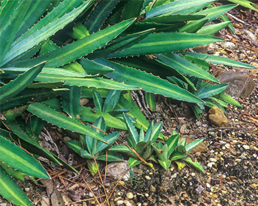Succulents reproduce in a number of different ways.
Most succulents flower, attract pollinators and form seeds in the way we’re all familiar with. Many succulents, such as the Agave known as the Century Plant, are monocarpic, meaning that they flower only once, at the end of their lifecycle. This may take years – although not a century!
In addition, many succulents form “pups” or “offsets,” juvenile plants that sprout from the base. If left alone, these will form root systems and extend the original plant into multi-plant clumps. Or they can easily be propagated by cutting them off and planting them in the ground.
Below are some young Thorn Crest Century Plant pups:

Even mature rosettes, leaves and stems can be harvested to grow into new plants. Let the cutting “harden off” by forming a callous on the end to prevent rot. Storage in a cool shaded place for a few days before planting should be sufficient.
If pups and seeds aren’t enough, some succulents also produce bulbils, miniature clones that develop on the flower stalk. These eventually will fall off or will be dispersed when the stalk topples over. Once on the ground, they form roots and grow!
However they’re propagated, good drainage is essential for succulents to thrive. If you have heavy clay, consider importing some well-drained soil to create mounds for planting.
For more information about all things succulents and cacti:
https://southcoastcss.org/
If you live in a high fire-risk zone, a succulent garden is ideal for you because of the plants ability to hold moisture. Plant low-growing succulents to make a defensible space within in thirty feet from your home and use a non-combustible mulch such as decorative gravel or pebbles around the succulents to suppress weeds.
For more information on fire resistant landscaping:
https://www.readyforwildfire.org/prepare-for-wildfire/get-ready/fire-resistant-landscaping/